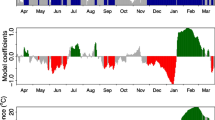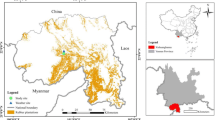Abstract
All rubber tree clones (Hevea brasiliensis) exhibit regular annual wintering characterized by senescence and abscission of leaves. After 3–4 weeks, this is followed by the onset of new leaves. It is likely that the timing of leaf onset affects the susceptibility of rubber trees to rubber powdery mildew disease, as this predominantly infests young leaves. However, little information is available on the phenological behavior of different rubber clones, or how meteorological factors affect such behavior. We assessed the wintering and flowering patterns of five rubber clones in Xishuangbanna, southwest China, based on observations made from 1978 to 2011, and evaluated how these patterns responded to different meteorological factors. Partial least squares regression was used to analyze the timing of defoliation, refoliation, and flowering. Our results showed that the two clones RRIM 600 and GT1 defoliated during the last week of December and refoliated in the last week of January, and clones Yunyan 277-5, Yunyan 34-4, and PR 107 defoliated during the first week of January and refoliated in the second week of February. The number of hours of sunshine during both the rainy season and the cold dry period in the dry season were important determinants of phenological changes in the rubber trees. Similarly, higher temperatures tended to delay the onset of defoliation and refoliation, and were a triggering factor for the onset of flowering. These results may help rubber cultivators to schedule appropriate disease control measures, as well as to design hybridization programs aiming at the production of clones which are resistant to foliar disease.






Similar content being viewed by others
References
Chapman EC (1991) The expansion of rubber in southern Yunnan, China. Geogr J 157(1):36–44
Chen H, Yi ZF, Schmidt-Vogt D, Ahrends A, Beckschäfer P, Kleinn C, Ranjitkar S, Xu J (2016) Pushing the limits: the pattern and dynamics of rubber monoculture expansion in Xishuangbanna, SW China. PLoS One 11(2):e0150062.
Chua SE (1970). The physiology of foliage senescence and abscission in Hevea brasiliensis Muell. Arg. Thesis submitted for the degree of Doctor of Philosophy, University of Singapore.
Fernando TM (1971) Oidium leaf disease-the effect of environment and control measures on incidence of disease and atmospheric spore concentration. Q Jl Rubb Res Inst Ceylon 48:100–111
Fox JM, Castella JC (2013) Expansion of rubber (Hevea brasiliensis) in mainland Southeast Asia: what are the prospects for small holders? J Peasant Stud 40(1):155–170
Fox J, Castella JC, Ziegler AD, Westley SB (2014). Rubber plantations expand in mountainous Southeast Asia: what are the consequences for the environment?
Fu Y, Zhang H, Dong W, Yuan W (2014) Comparison of phenology models for predicting the onset of growing season over the northern hemisphere. PLoS One 9(10):e109544. https://doi.org/10.1371/journal.pone.0109544
Ge Q, Wang H, Rutishauser T, Dai J (2015) Phenological response to climate change in China: a meta-analysis. Glob Chang Biol 21(1):265–274
Guyot J, Cilas C, Sache I (2008) Influence of host resistance and phenology on South American leaf blight of the rubber tree with special consideration of temporal dynamics. Eur J Plant Pathol 120(2):111–124
Jialin S, Zhuotong Y, Qianchun X, Wuren H (1999) Histological study of Hevea clones resistant to powdery mildew. Chin J Tropical Crops 02:24–30
Körner C, Basler D (2010) Phenology under global warming. Science 327:1461–1462
Kudoh H (2016) Molecular phenology in plants: in natura systems biology for the comprehensive understanding of seasonal responses under natural environments. New Phytol 210:399–412
Li Z, Fox JM (2012) Mapping rubber tree growth in mainland Southeast Asia using time-series MODIS 250 m NDVI and statistical data. Appl Geogr 32(2):420–432
Li H, Aide TM, Ma Y, Liu W, Cao M (2007) Demand for rubber is causing the loss of high diversity rain forest in SW China. Biodivers Conserv 16(6):1731–1745. https://doi.org/10Ð1007/s10531-006-9052-7
Limkaisang S, Kom-un S, Furtado EL, Liew KW, Salleh B, Sato Y, Takamatsu S (2005) Molecular phylogenetic and morphological analyses of Oidium heveae, a powdery mildew of rubber tree. Mycoscience 46(4):220–226
Liyanage AS (1976) Influence of some factors on the pattern of wintering and on the incidence of Oidium leaf fall in clone PB 86. J Rubber Res Inst Sri Lanka 53:31–38
Liyanage KK, Khan S, Mortimer PE, Hyde KD, Xu J, Brooks S, Ming Z (2016) Powdery mildew disease of rubber tree. For Pathol 46:90–103. https://doi.org/10.1111/efp.12271
Meenattoor RJ, Krishnakumar AK, Sinha RR, Potty SN (1989) Flowering pattern of Hevea clones in Tripura. Indian J Nat Rubber Res 2(2):139–142
Miller-Rushing AJ, Inouye DW, Primack RB (2008) How well do first flowering dates measure plant responses to climate change? The effects of population size and sampling frequency. J Ecol 96:1289–1296
Mitra M, Mehta PR (1938) Some leaf diseases of Hevea brasiliensis new to India. Indian J Agric Sci 8:185–188
Nokels, L., Fahmy, T., and Crochemore, S. (2010). Interpretation of the preferences of automotive customers applied to air conditioning supports by combining GPA and PLS regression. Handbook of Partial Least Squares, 775-789
Peries OS (1974). The disease of Hevea: problems and progress by 2000 AD. Proceedings of the Rubber Planters Conferences, Cochin, India, 6, 1–6
Priyadarshan PM, Sasikumar S, de Gonslaves PS (2001) Phenological changes in Hevea brasiliensis under differential geo-climates. Planter 77:447–459
Priyadarshan PM, Hoa TTT, Huasun H, de Gonçalves PS (2005) Yielding potential of rubber (Hevea brasiliensis) in sub-optimal environments. J Crop Improv 14(1–2):221–247
R Development Core Team (2013). R: a language and environment for statistical computing. R Foundation for Statistical Computing, Vienna, Austria. ISBN 3-900051-07-0, URL http://www.R-project.org/
Ranjitkar S, Luedeling E, Shrestha KK, Guan K, Xu J (2013) Flowering phenology of tree rhododendron along an elevation gradient in two sites in the Eastern Himalayas. Int J Biometeorol 57:225–240
Rao PS, Vijayakumar KR (1992) Climatic requirements. Natural rubber: biology, cultivation and technology, pp.200–19
Rattanawong R (2012) QTL mapping in Hevea brasiliensis for analysing the genetic determinism of growth, latex production, and the macromolecular structure of natural rubber. PhD dissertation, Graduate School, Kasetsart University
Robbirt KM, Davy AJ, Hutchings MJ, Roberts DL (2011) Validation of biological collections as a source of phenological data for use in climate change studies: a case study with the orchid Ophrys sphegodes. J Ecol 99(1):235–241
Seneviratne P (1996) The growth phase change and rejuvenation of trees with special reference to Hevea brasiliensis (Muell. Arg.). J Rubber Res Inst Sri Lanka 78:1–14
Suryakumar M, Vinod KK, Manju MJ, Saraswathyamma CK, Nazeer MA (2002). Studies on wintering and flowering pattern of different Hevea clones in costal Karnataka. Proceeding of Placrosym. XV:120–127
Veriankaite L, Šauliene I, Bukantis A (2010) Analysis of changes in flowering phases and airborne pollen dispersion of the genus Betula (birch). J Environ Eng Landsc Manag 18(2):137–144
Vinod KK, Rajeswari MJ, Jacob P, Krishnakumar AK, Sethuraj MR (1996) Performance analysis for wintering pattern in Hevea brasiliensis clones. Indian J Nat Rubber Res 9(1):44–47
Wold S (1995) PLS for multivariate linear modeling. In: van der Waterbeemd H (ed) Chemometric methods in molecular design: methods and principles in medicinal chemistry. Verlag-Chemie, Weinheim, pp 195–218
Yeang HY (2007) The sunshine-mediated trigger of synchronous flowering in the tropics: the rubber tree as a study model. New Phytol 176(4):730–735. https://doi.org/10.1111/j.1469-8137.2007.02258.x
Zhao J, Zhang Y, Song F, Xu Z, Xiao L (2013) Phenological response of tropical plants to regional climate change in Xishuangbanna, Southwestern China. J Trop Ecol 29:161–172
Zhu Y, Xu J, Li Q, Mortimer PE (2014) Investigation of rubber seed yield in Xishuangbanna and estimation of rubber seed oil based biodiesel potential in Southeast Asia. Energy 69:837–842. https://doi.org/10.1016/j.energy.2014.03.079
Acknowledgements
We would like to thank CGIAR Research Program 6: Forests, Trees and Agroforestry, and Key Research Program of Frontier Sciences, CAS, Grant No. QYZDY-SSW-SMC014. This work was partially supported by We would like to thank the National Natural Science Foundation (NSFC), China for Grant No. 151853KYSB20160032, 31550110215, 31650410651, 41661144001, 41761144055, 31750110478, and 41771063. The authors thank Mr. Andrew Stevenson, World Agroforestry Centre (ICRAF), East and Central Asia Office, Kunming, Yunnan, China for English editing of the manuscript.
Author information
Authors and Affiliations
Corresponding authors
Rights and permissions
About this article
Cite this article
Liyanage, K., Khan, S., Ranjitkar, S. et al. Evaluation of key meteorological determinants of wintering and flowering patterns of five rubber clones in Xishuangbanna, Yunnan, China. Int J Biometeorol 63, 617–625 (2019). https://doi.org/10.1007/s00484-018-1598-z
Received:
Revised:
Accepted:
Published:
Issue Date:
DOI: https://doi.org/10.1007/s00484-018-1598-z




